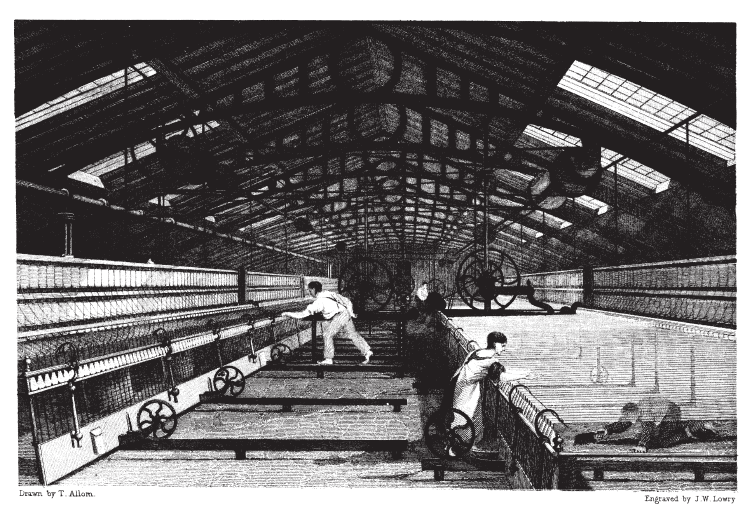Regulation of the Workplace
Growth in the number of factory workers across Britain during the nineteenth century raised awareness of factory conditions.

Children working in a cotton mill, 1835.
From 1833 a series of Factory Acts were passed by Parliament to control working hours and who could work in factories. The knitting industry remained largely unaffected by the early acts as before the 1850s it was still a domestically based industry.
Children in the industry
The Children's Employment Commission in 1862 investigated the use of children in industry and included a section on the knitting industry. The Commission report noted that despite the move towards steam-powered factory production, domestic production of high quality work was likely to continue for a number of years. With many young people working at home in the industry, the Commission considered that legislation should protect these workers. Common jobs for children were winding and seaming, with reported cases of children as young as three and a half being given tasks to do. The report noted evidence from child workers that they worked long hours in factories, often outside the hours set out in the 1850 Act.
Workshop watch
The 1867 Workshops Act extended the protection of the Factory Acts to workers in small workshops employing less than 50 people. The Act was difficult to enforce due to the number of workshops in existence. Villages associated with the knitting industry often had a workshop in almost every house and the task of checking them all was almost impossible. This was particularly a problem at night when inspectors had to find workers who did not follow the correct working hours. The 1876 Factory Acts Commission recorded that people continued to work over the ten and a half hour working day and beyond the times set out for the working day.
Education for children
The growth of factory employment enabled inspectors to more closely monitor working conditions in the knitting industry. The transition to factories was delayed by the continued availability of cheap labour in the domestic industry, particularly that provided by children. A requirement for those under thirteen to receive part time education was included in the Factory and Workshop Acts. The lack of school places prevented the clause being effective. The 1870 Education Act provided elementary education to tackle this problem. In 1876 a further act introduced compulsory education for children. With the supply of cheap child labour gone, the transition to factory production rapidly increased.
Frame rents abolished
The abolition of frame rents by the Hosiery Manufacture (Wages) Act in 1874 also reduced the incentive of employers to continue to use domestic workers. Employers were no longer able to charge workers for the use of their frames. This ended a contentious but profitable source of income for the frame owners.